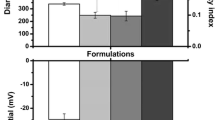No Heading
Purpose.
To evaluate the effect of hydrophilic cyclodextrins (CyDs) on the aggregation induced by different stresses and on the oxidation and deamidation of recombinant human growth hormone (rhGH).
Methods.
The aggregation of rhGH was induced by three denaturing techniques including chemical (4.5 M guanidine hydrochloride), thermal (differential scanning calorimetry), and interfacial denaturation (vortex agitation). The aggregates were characterized and quantified by UV spectrophotometry and size exclusion chromatography. The effects of hydrophilic CyDs on deamidation and oxidation rates of rhGH were studied by HPLC method.
Results.
In both thermally and chemically induced aggregations, branched β-CyDs significantly inhibited the aggregation of rhGH compared with the other α- and γ-CyDs. This can explain that the β-CyD cavity with branched sugar moieties may be relatively preferable in preventing the aggregation of rhGH. In contrast, 2-hydroxypropyl β-CyD with surface activity was found to be effective in reducing the aggregation induced by interfacial denaturation compared with those of branched β-CyDs. On the other hand, these hydrophilic CyDs showed no noticeable inhibitory effect on the oxidation and deamidation rates of rhGH. The results suggested that CyDs interact preferably with exposed hydrophobic side chains rather than aliphatic side chains of rhGH, resulting in the inhibition of aggregation but not the oxidation and deamidation rates.
Conclusions.
The different inhibitory effect of CyDs is dependent not only on the structure and property of CyD itself but also the nature of the denaturing stimulus. The current results suggested that hydrophilic β-CyDs can effectively inhibit the aggregation of rhGH. Thus, hydrophilic β-CyDs may be potentially useful excipients for parenteral preparation of rhGH.
Similar content being viewed by others
References
1. H. LeVine 3rd and J. D. Scholten. Screening for pharmacological inhibitors of amyloid fibril formation. Methods Enzymol. 309:467–476 (1999).
2. C. M. Dobson. Protein folding and misfolding. Nature 426:884–890 (2003).
3. S. W. Raso and J. King. Protein folding and human disease. In R. H. Pain (ed.), Mechanisms of Protein Folding, IRL Press, Oxford, 2000 pp. 406–428.
4. J. L. Cleland, M. F. Powell, and S. J. Shire. The development of stable protein formulations: A close look at protein aggregation, deamidation, and oxidation. Crit. Rev. Ther. Drug Carr. Syst. 10:307–377 (1993).
5. M. C. Manningm, K. Patel, and R. T. Borchardt. Stability of protein pharmaceuticals. Pharm. Res. 6:903–918 (1989).
6. N. Karuppiah and A. Sharma. Cyclodextrins as protein folding aids. Biochem. Biophys. Res. Commun. 211:60–66 (1995).
7. L. Szente and J. Szejtli. Highly soluble cyclodextrin derivatives: chemistry, properties and trends in development. Adv. Drug Deliv. Rev. 36:17–28 (1999).
8. K. Uekama, F. Hirayama, and T. Irie. Cyclodextrin drug carrier system. Chem. Rev. 98:2045–2076 (1998).
9. K. Tokihiro, T. Irie, and K. Uekama. Varying effects of cyclodextrin derivatives on aggregation and thermal behavior of insulin in aqueous solution. Chem. Pharm. Bull. (Tokyo) 45:525–531 (1997).
10. K. Matsubara, Y. Ando, T. Irie, and K. Uekama. Protection afforded by maltosyl-β-cyclodextrin against α-chymotrypsin-catalyzed hydrolysis of a luteinizing hormone-releasing hormone agonist, buserelin acetate. Pharm. Res. 14:1401–1405 (1997).
11. M. E. Brewster, M. S. Hora, J. W. Simpkins, and N. Bodor. Use of 2-hydroxypropyl- β-cyclodextrin as a solubilizing and stabilizing excipient for protein drugs. Pharm. Res. 8:792–795 (1991).
12. R. L. Scott. Some comments on Benesi-Hildebrand equation. Rec. Trav. Chim 75:787–789 (1956).
13. G. Teshima and E. C. Davis. Separation of oxidized human growth hormone variants by reversed-phase high-performance liquid chromatography: Effect of mobile phase pH and organic modifier. J. Chromatogr 625:207–215 (1992).
14. J. L. Cleland, A. Mac, B. Boyd, J. Yang, E. T. Duenas, D. Yeung, D. Brooks, C. Hsu, H. Chu, V. Mukku, and A. J. S. Jones. The stability of recombinant human growth hormone in poly (lactic-co-glycolic acid) (PLGA) microsphere. Pharm. Res. 14:420–425 (1997).
15. N. B. Bam, J. L. Cleland, and T. W. Randolph. Molten globule intermediate of recombinant human growth hormone: Stabilization with surfactants. Biotechnol. Prog. 12:801–809 (1996).
16. M. Dadlez. Hydrophobic interactions accelerate early stages of the folding of BPT1J. Biochemistry 36:2788–2779 (1997).
17. T. Arakawa and S. N. Timasheff. Stabilization of protein structure by sugars. Biochemistry 21:6536–6544 (1982).
18. D. E. Otzen, B. R. Knudsen, F. Aachmann, K. L. Larsen, and R. Wimmer. Structural basis for cyclodextrins’ suppression of human growth hormone aggregation. Protein Sci. 11:1779–1787 (2002).
19. W. C. Cromwell, K. Byström, and M. R. Eftink. Cyclodextrin-adamantanecarboxylate inclusion complexes: Studies of the variation in cavity size. J. Phys. Chem. 89:326–332 (1985).
20. I. Jelesarov and H. R. Bosshard. Isothermal titration calorimetry and differential scanning calorimetry as complementary tools to investigate the energetics of biomolecular recognition. J. Mol. Recognit. 12:3–18 (1999).
21. I. G. Orellana, B. Variano, J. M. Fraboni, S. Milstein, and D. R. Paton. Thermodynamic characterization of an intermediate state of human growth hormone. Protein Sci. 7:1352–1358 (1998).
22. M. Katanam, L. N. Bell, and A. K. Banga. Effect of surfactants on the physical stability of recombinant human growth hormone. J. Pharm. Sci. 84:713–716 (1995).
23. S. Tavornvipas, F. Hirayama, H. Arima, K. Uekama, T. Ishiguro, M. Oka, K. Hamayasu, and H. Hashimoto. 6-O-α-(4-O-α-D-glucuronyl)-D-glucosyl-β-cyclodextrin: Solubilizing ability and some cellular effects. Int. J. Pharm. 249:199–209 (2002).
24. S. A. Charman, K. L. Mason, and W. N. Charman. Techniques for assessing the effects of pharmaceutical excipients on the aggregation of porcine growth hormone. Pharm. Res. 10:954–962 (1993).
25. R. A. Houghten, C. B. Glaser, and C. H. Li. Human somatotropin reaction with hydrogen peroxide. Arch. Biochem. Biophys. 178:350–355 (1977).
26. R. Pearlman and T. A. Bewley. In J. Y. Wang and R. Pearlman (eds.), Stability and Characterization of Protein and Peptide Drugs: Case Histories, Plenum Press, New York, 1993, pp.1–58.
Author information
Authors and Affiliations
Corresponding author
Rights and permissions
About this article
Cite this article
Tavornvipas, S., Tajiri, S., Hirayama, F. et al. Effects of Hydrophilic Cyclodextrins on Aggregation of Recombinant Human Growth Hormone. Pharm Res 21, 2369–2376 (2004). https://doi.org/10.1007/s11095-004-7691-5
Received:
Accepted:
Published:
Issue Date:
DOI: https://doi.org/10.1007/s11095-004-7691-5




